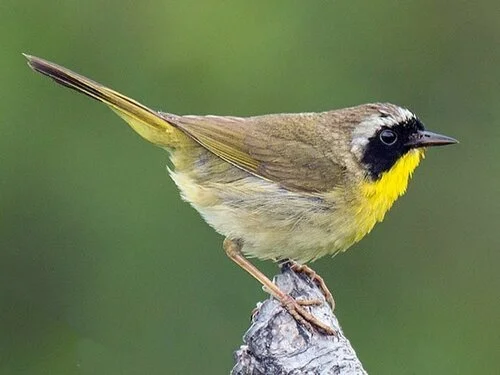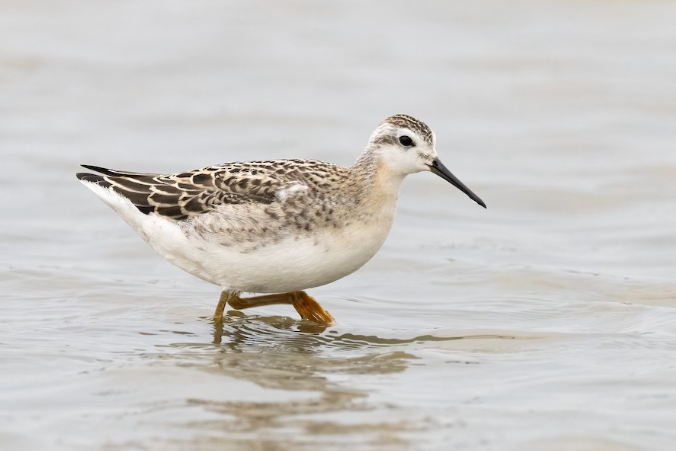Week 8: Advanced
Scroll down to study the birds by sight and sound, and then take the quiz.
Week 8 Birds
Gray Catbird, Northern Mockingbird, Say’s Phoebe, Willow Flycatcher, Warbling Vireo, Common Yellowthroat, Yellow-breasted Chat, Lazuli Bunting




GRAY CATBIRD
Bird Code: GRCA
Identify this bird by…
Small black cap
Blackish tail
Cinnamon brown patch under tail
Males and females look alike
Look for…
Behavior - secretive but energetic, hopping and fluttering from branch to branch through tangles of vegetation. Singing males sit atop shrubs and small trees.
Habitat - Dense tangles of shrubs, small trees, and vines, along forest edges, streamside thickets, and old fields
Listen for…
Song: Mixture of melodious, nasal, and squeaky notes interspersed with catlike mew notes. Some are good mimics, but they do not usually repeat phrases like others.
Call: Most common call is a raspy mew that sounds like a cat. Catbirds also make a loud, chattering chek-chek-chek and a quiet quirt.
Resources:



NORTHERN MOCKINGBIRD
Bird Code: NOMO
Identify this bird by…
Medium-sized songbird with a long tail.
Pale gray with a whitish belly, dark eyeline, darker wings and tail
In flight, shows white outer tail feathers and bold white patches in the wings.
Listen for…
Call: a harsh dry “chak”
Song: a series of varied repeated phrases. Each phrase is repeated two to six times.
Resources:








SAY’S PHOEBE
Bird Code: SAPH
Identify this bird by…
A slender flycatcher often found in open settings.
The American Robin of flycatchers: is brownish-gray above with a pale rufous belly and a long square black tail
Listen for…
Call: a low, plaintive “pdeer”
Song: a couple clear, descending whistle followed by a little burry hiccupping note, often repeated
Resources:
WILLOW FLYCATCHER
Bird Code: WIFL
Identify this bird by
Fairly long, thin tail and wings. The bill is broad
Like other flycatchers, they tend to perch upright
Males and females look alike
Tell it apart by…
Brownish olive overall with a slight yellow wash to the belly
2 whitish wingbars and a white throat that contrasts with the brownish olive breast
The white eyering seen on most flycatchers is very thin and nearly absent on Willow Flycatchers
Look for…
Behavior - Flit between willows and other shrubs in the understory while calling. They stick close to willows perching on the edge or up on top of the shrub. From these perches they fly out to catch insects or sing
Listen for…
Song: Songs are often the key to their identity and this one sings a hoarse fitz-bew from high perches in their territory
Call: A soft, dry whit
Resources:







WARBLING VIREO
Bird Code: WAVI
Identify this bird by…
Small songbird with a thicker bill
Brownish upperparts that lack wing bars
Subdued face pattern with brownish line through the eye (strongest behind the eye)
Pale line over the eye
Males and females look alike!
Regional differences…
Individuals in the Rocky Mountains and west have darker gray-brown heads and sing a different song than those in the east
Look for…
Behavior - They forage “sluggishly,” intently peering at leaf surfaces from a single perch before pouncing or moving on
Listen for…
Song: a rapid, undulating song that usually concludes with an accented high note. It might sound like “higglety-pigglety- pigglety-pigglety-PIK!”
Call: Many calls, but particularly a raspy, descending, scold call
Resources:
COMMON YELLOWTHROAT
Bird Code: COYE
Identify this bird by…
Small songbird with chunky, rounded heads and medium-length, slightly rounded tails
Signature yellow throat
Tell males and females apart by…
Males - Broad black mask bordered above by white and below by a bright yellow throat. They have olive colored back parts
Females - Lack the black mask and are plain olive brown with brighter yellow under throat and tail
Immature - Immature males look similar to adult females but they have a faint patchy black mask. Immature females are pale brownish overall with yellow only under the tail
Look for…
Spend much of their time skulking low to the ground in dense thickets and fields, searching for small insects and spiders
Listen for…
Song - Males sing a distinctive witchety-witchety-witchety song, about 2 seconds long, to defend the territory and attract females.
Males sing frequently, averaging as high as 125 songs per hour and sometimes reaching 300 songs per hour!
Call - Both males and females give a strong chuck when potential predators approach
Resources:



YELLOW-BREASTED CHAT
Bird Code: YBCH
Identify this bird by…
Large and warbler like with a long tail
Thick bill and white “spectacles” and a white “mustache”
Bright yellow breast
Males and females look alike
Look for…
Behavior - loud birds that tend to skulk in low, thick brush. In spring, males may sing from an exposed perch, but otherwise these birds typically stay well hidden
Regional differences - Western birds typically have longer tails, are more olive, and have a longer white moustachial stripe
Listen for…
Song: Extremely varied, and is mostly simple notes repeated in a decelerating series or given singly with a pause between each utterance. It is often full of squeaks, rattles, and clucks–listen for these harsher, chattering notes to distinguish it from the squeakier, more musical Gray Catbird.
Call: A distinctive harsh scolding. Females also make a gargling growl when disturbed at the nest. Wintering males and females give a “chuck” call to defend winter territories
Resources:





LAZULI BUNTING
Bird Code: LAZB
Identify this bird by…
Small, stocky, and finchlike
Cone shaped bills and a gently sloping forehead
Tail is notched or slightly forked
Tell males and females apart by…
Males: Breeding males are brilliant blue above with a pumpkin colored breast and a white belly. They also have a white should patch. Non-breeding males and juveniles have a pumpkin colored breast, but their backs and heads are mottled blue and tan
Females: Warm grayish brown above, with a blue tinge to wings and tail, two buffy wingbars, and an unstreaked pale tan breast
Look for…
Perch upright and sing from exposed perches
Listen for…
Song: A high series of warbled phrases. Listen for the buzzy quality to the notes at the end of the song, which will help to distinguish it from the Yellow Warbler
Call: Sharp, metallic pik
Resources:
WEEK 8 WETLAND EXTRAS
Study these birds if you are interested in surveying at Legacy Nature Preserve, the Great Salt Lake Shorelands Preserve, and Utah Lake North Shore.




EASTERN KINGBIRD
Bird Code: EAKI
Identify this bird by…
Sturdy, medium-sized songbird with a large head
Upright posture
Relatively short, straight bill
Males and females look alike
Tell it apart by…
Black-head and blackish back
Distinct white-tipped, square tail
White underparts
Look for…
Behavior - They are visual hunters, sallying out from perches to snatch flying insects
Listen for…
Song: The EAKI song is very excited and rapid, with a stuttered quality- it sounds a little like electrical notes jumping between two wires
Call: A variety of high-pitched, short, explosive calls with an electric quality
Resources:



WILSON’S SNIPE
Bird Code: WISN
Identify this bird by…
A plump medium-sized songbird with a long bill and eyes placed far back on its head.
Brown with heavy barring on the flanks, a striped head, and three long cream-colored stripes down its back.
In flight, shows a dark underwing and white belly.
Listen for…
Call: make a “scaipe” call, or repeated hard, sharp “jick”s
Other: Make a haunting winnowing sound as air rushes through their tail feathers
Resources:




WILLET
Bird Code: WILL
Identify this bird by…
A large, stocky, drab shorebird with long legs and a straight bill.
Gray and plain-looking when on the ground with barring on breast in breeding Adults.
In flight, show a striking black and white wing pattern and white rump
Listen for…
Song: a very distinctive repeated “will-willet, will-willet, will-willet” display song.
Resources:
All About Birds (link to all about birds profile)



WILSON’S PHALAROPE
Bird Code: WIPH
Identify this bird by…
A small, active shorebird with long pale yellow legs, a slender neck, and a very thin straight black bill
Non-breeding adults are pale gray above with a white face and belly
Breeding adult females have a peachy neck with a dark stripe down the side and a blue-gray back. Breeding males are duller than females and lack the dark neck stripe.
In flight, have plain gray wings, white underneath, and a white rump
Listen for…
Call: a soft but distinctive, muffled “vimp”
Resources:
